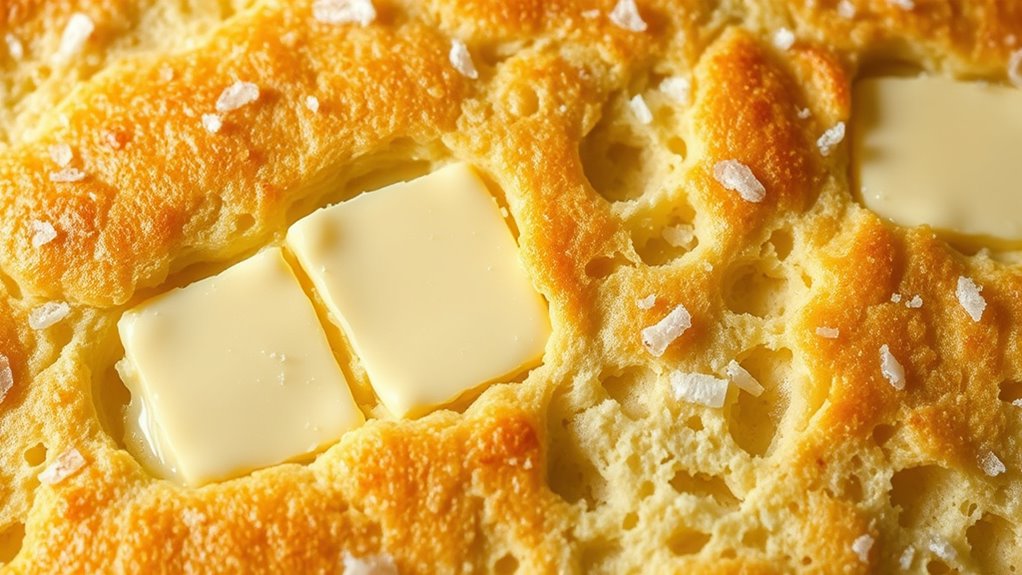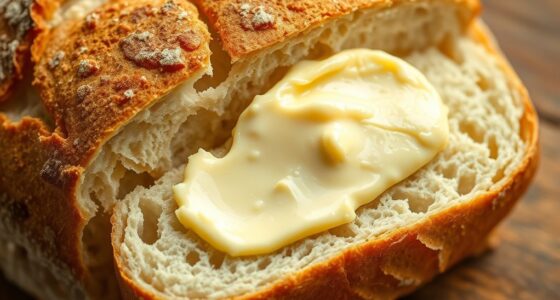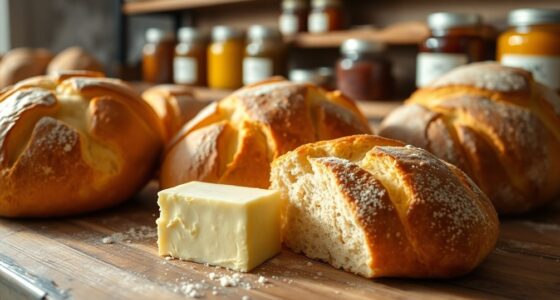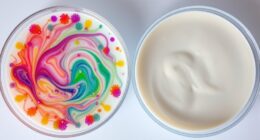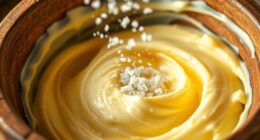Salted butter affects gluten structure in focaccia by coating flour proteins, which limits water absorption and slows gluten development. The fat from butter weakens the gluten network, making the dough softer and more tender. Salt tightens gluten bonds, further impacting elasticity. Using butter carefully—like softening or adding it gradually—can help you maintain a good structure while enjoying a moist, flavorful focaccia. Keep exploring how to balance ingredients and techniques for the best results.
Key Takeaways
- Salted butter coats gluten proteins, hindering gluten network formation and reducing dough elasticity.
- The fat from butter interferes with gluten strand bonding, resulting in a softer, less dense gluten structure.
- Melting butter creates pockets that weaken the gluten matrix, making the dough more tender and extensible.
- Salt tightens gluten networks, limiting water absorption and further affecting gluten development.
- Properly incorporated butter softens the dough and enhances crumb tenderness without overly compromising gluten strength.
The Role of Gluten in Focaccia Dough
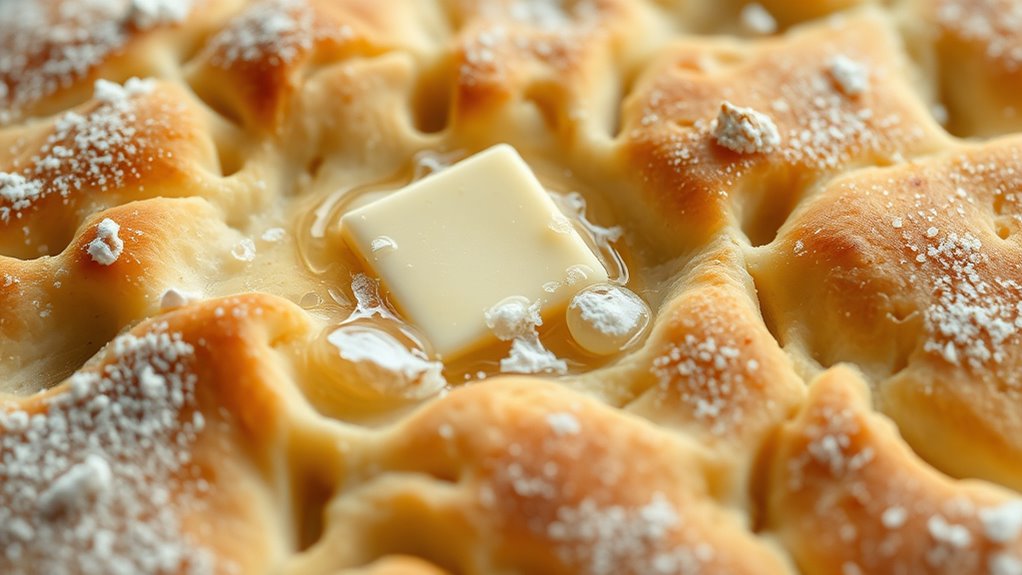
Gluten plays a crucial role in giving focaccia its characteristic texture and structure. When you mix flour and water, gluten proteins form a gluten network that provides the dough with strength and flexibility. This network is essential for trapping gas bubbles produced during fermentation, allowing the dough to rise and develop a light, airy crumb. The elasticity of your dough depends on how well the gluten strands stretch without breaking, which influences the final texture. Proper kneading helps develop this dough elasticity, ensuring a resilient gluten structure. Without a strong gluten network, your focaccia might turn out dense or flat. By managing gluten development through mixing and kneading, you control the dough’s ability to hold its shape and achieve that perfect, chewy bite. Additionally, incorporating techniques such as resting the dough can further enhance gluten development and improve overall bread quality.
How Butter Interacts With Gluten Proteins
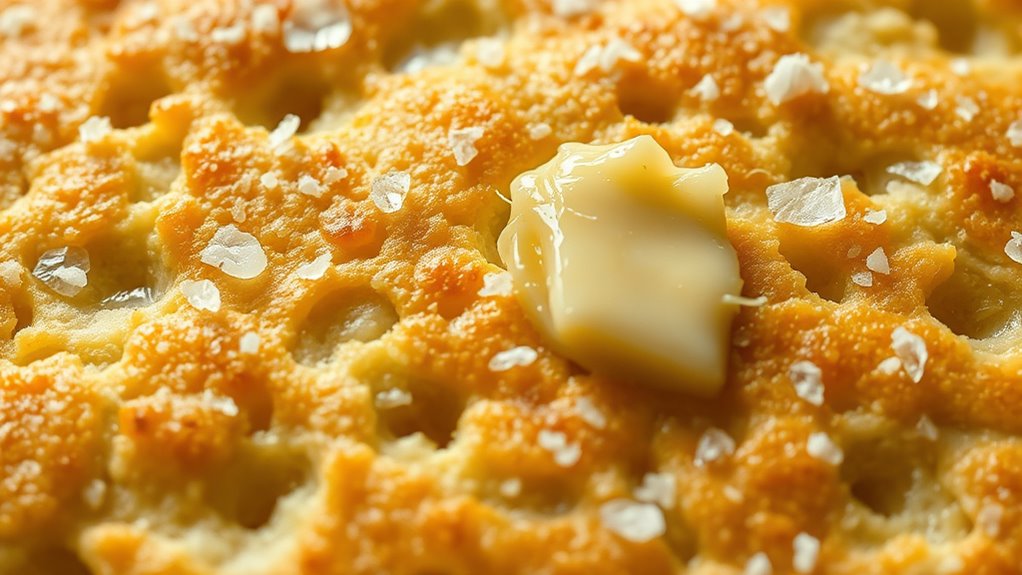
Butter interacts with gluten proteins by coating their surfaces, which can weaken the gluten network and reduce dough elasticity. This happens because butter emulsification disperses fat molecules evenly throughout the dough, creating a thin layer around gluten strands. This coating hinders gluten cross linking, essential for forming a strong, elastic gluten matrix. As a result, the dough becomes less stretchable and more tender. The fats from butter interfere with the formation of hydrogen bonds between gluten proteins, disrupting their ability to bond tightly. This interaction can produce a softer, more tender crumb in your focaccia. Additionally, understanding the role of fats in gluten structure helps bakers manipulate dough characteristics effectively. However, too much butter may overly weaken the gluten network, leading to a dough that lacks structure. Understanding how butter influences gluten helps you control dough texture and achieve the desired focaccia quality.
Effects of Salted Butter on Dough Hydration and Texture

Adding salted butter to your dough can change how it absorbs water, affecting overall hydration. This alteration influences the dough’s elasticity and how the crumb develops during baking. Understanding these effects helps you achieve the desired texture and mouthfeel in your focaccia. Additionally, the presence of butter can contribute to a rich flavor and tender crumb that enhances the overall eating experience.
Hydration Level Changes
When salted butter is incorporated into focaccia dough, it can substantially influence the hydration level and resulting texture. As the butter melts, it coats flour particles, reducing their ability to absorb water, which lowers overall dough hydration. The salt influence further complicates this process; salt can tighten gluten networks, limiting water absorption and making the dough stiffer. This interaction means you might notice a slightly drier dough than usual, even with the same amount of added water. Adjustments in hydration may be necessary to compensate for the butter’s fat content and salt’s tightening effect. The role of gluten in dough development is crucial in understanding how these ingredients impact texture and structure. Balancing these factors ensures the dough remains workable and develops the desired elasticity, ultimately affecting the final bread’s structure and mouthfeel.
Texture and Crumb Impact
Incorporating salted butter into focaccia dough considerably influences its final texture and crumb structure. As the butter melts during baking, it tenderizes the crumb, making it softer and more open. The melting process creates pockets of fat that improve moisture retention, resulting in a moist, airy crumb. The salt influence is also significant; it strengthens gluten networks, providing better structure and chewiness. Salted butter adds richness without overwhelming the dough’s balance, enhancing the overall mouthfeel. This combination leads to a more tender, moist crumb with delicate air pockets, contrasting with leaner doughs. Additionally, the presence of self-watering properties in certain ingredients can help maintain consistent moisture levels during baking, further refining the crumb texture. Ultimately, the butter’s melting and salt’s influence work together to produce a focaccia with a refined, satisfying texture that’s both moist and well-structured.
The Impact of Fat Content on Gluten Development

Fat content plays a crucial role in shaping the structure of gluten in focaccia dough. When butter melts into the dough, it helps disperse fat evenly, which can interfere with gluten formation. Higher fat levels tend to coat gluten strands, making the dough softer and less elastic. This coating prevents gluten from developing strong, elastic networks, resulting in a tender crumb. Conversely, lower fat content allows gluten to develop more fully, producing a chewier texture. The balance of fat influences dough extensibility and strength, affecting how it rises and holds shape. Additionally, understanding the role of fats in baking can help bakers manipulate dough properties to achieve desired textures. By understanding how butter’s melting and fat dispersion impact gluten development, you can better control the final texture of your focaccia, ensuring it’s light yet structured.
Adjusting Techniques When Using Butter in Focaccia
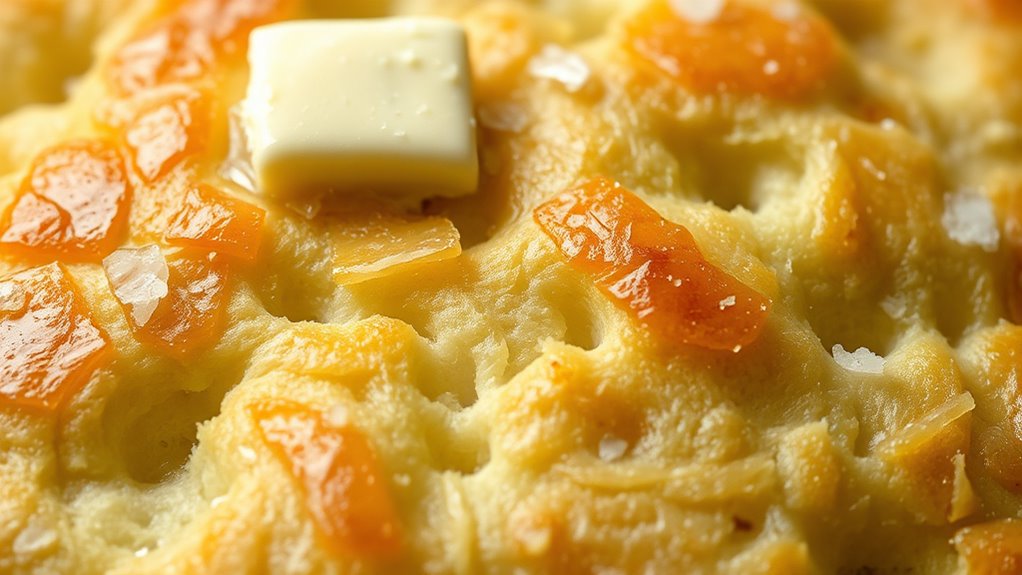
To optimize the use of butter in your focaccia, you should consider techniques that control how the fat interacts with the dough. One effective approach is to add small pieces of butter gradually, allowing it to melt slowly and evenly, which helps integrate it without disrupting gluten formation. Using melted butter early can lead to uneven butter melting, so consider adding softened or cold butter and mixing thoroughly. This technique enhances flavor, as butter melts into the dough, infusing it with richness and aroma. You can also brush melted butter onto the dough’s surface before baking for extra flavor enhancement and a tender crust. Adjusting your method ensures the butter’s melting process supports a balanced gluten structure while maximizing the flavor impact. Additionally, understanding how gluten structure interacts with fats can help you refine your technique further for the best results.
Tips for Achieving Optimal Gluten Structure With Butter
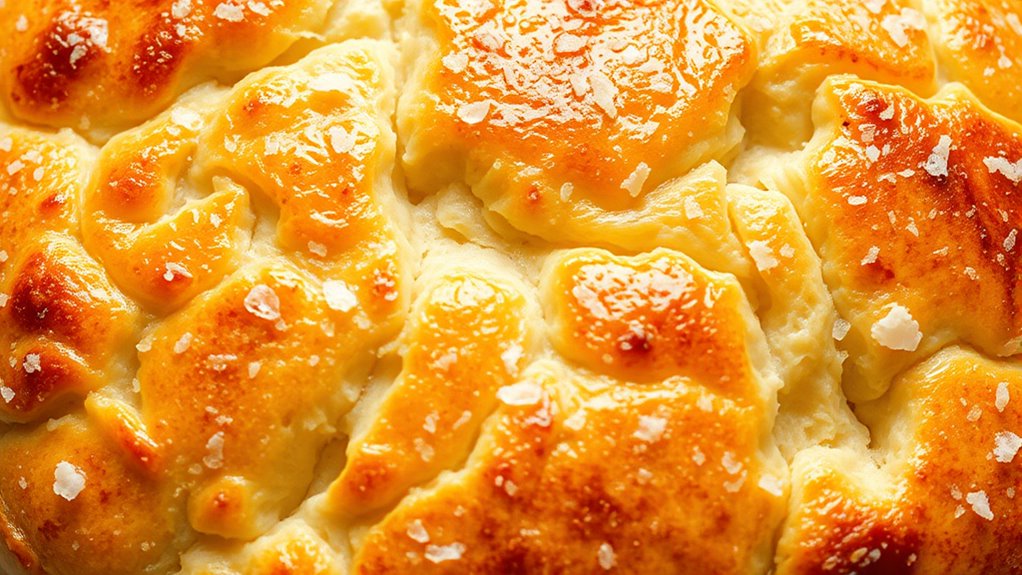
Achieving a strong gluten structure while using butter requires careful handling to prevent the fat from weakening the dough. To do this, add butter gradually during mixing, allowing the gluten to develop fully before incorporating more fat. Keep the butter at room temperature or slightly softened to guarantee even distribution without disrupting the gluten network. Be mindful of butter’s melting point; if it melts too quickly, it can coat gluten strands and hinder their formation. For ideal results, incorporate butter in small pieces and mix thoroughly but gently. This preserves the butter’s flavor while maintaining the dough’s elasticity. Proper handling ensures the butter enhances the focaccia’s richness without compromising its gluten structure, resulting in a well-textured, flavorful loaf. Additionally, understanding how food chemistry influences dough behavior can help you optimize your technique for better results.
Frequently Asked Questions
Does Salted Butter Affect Fermentation Time in Focaccia Dough?
Salted butter can influence fermentation time in your focaccia dough because its fat content and salt sensitivity affect how quickly yeast works. When you add butter, it slows down gluten absorption, delaying fermentation slightly. The salt in salted butter also controls yeast activity, so your dough might ferment a bit longer or more evenly. Keep an eye on how your dough develops, as these factors interact to shape your bread’s texture.
Can Salted Butter Change the Flavor Profile of the Final Focaccia?
Did you know that adding salted butter can enhance the flavor of your focaccia? Salted butter boosts flavor enhancement by balancing the dough’s natural sweetness. The salt concentration in the butter influences the final taste, making it more savory and rich. So, yes, salted butter definitely changes the flavor profile, giving your focaccia a deeper, more complex flavor that’s sure to impress.
How Does Butter Temperature Influence Gluten Development?
You’ll notice that butter temperature plays a key role in gluten development. When butter melts at different temperatures, it influences the dough temperature, affecting how the gluten forms. If you use cold butter, it keeps the dough cooler, slowing gluten development. Conversely, melted or warm butter raises the dough temperature, speeding up gluten formation. Controlling butter temperature guarantees you get the right gluten structure for a perfect focaccia.
Is There a Difference Between Salted and Unsalted Butter in Dough Elasticity?
Imagine your dough as a melody, where each ingredient adds a note. Salted butter introduces a subtle harmony; its salt content enhances flavor and influences dough elasticity. Unsalted butter, on the other hand, leaves the tune more neutral, letting other flavors shine. While both soften gluten, salted butter’s salt can tighten the gluten network slightly, giving your focaccia a sturdier structure and richer flavor.
What Are Common Mistakes When Incorporating Butter Into Focaccia Dough?
When incorporating butter into focaccia dough, you might overmix it, which weakens gluten structure and results in a dense crumb. Avoid uneven butter distribution by cutting the butter into small pieces and folding it gently into the dough. Be patient and mix just enough to incorporate the butter smoothly, ensuring a well-hydrated, airy dough that bakes into a tender, flavorful focaccia.
Conclusion
By balancing butter’s richness with proper technique, you’ll build a beautiful, bouncy focaccia. Salted butter subtly smooths and strengthens gluten, giving your bread its signature structure and softness. Embrace the interplay of ingredients, adjusting techniques to achieve the ideal dough dynamics. With patience and practice, you’ll produce perfectly plump, fluffy focaccia that’s flavorful and fabulous. Flourish your baking skills by focusing on finesse, flavor, and the fascinating effects of butter on gluten’s glorious growth.
